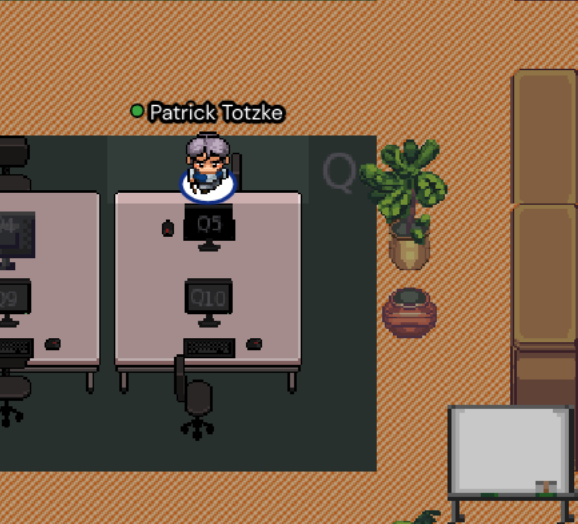Using Gather.town for teaching
Many of our undergraduate modules are delivered in a large part as hands-on programming labs where exercises are solved individually in a supervised setting. I decided to move lab teaching to Gather.town, so far with great success. Below I outline my experiences with this, and adjustments made, and feedback.
First Impressions
Gather.town is a web-based videochat platform. It looks and feels like a game and naturally encourages social interaction. Its key idea is that you’re automatically connected to anyone in your close proximity.
Features relevant to lab teaching are screen sharing, kick/banning of hecklers and a raise-hand feature. Participants do not need to sign up. Logins are via a “magic link” sent to any valid email address. For more check out the video demo below or have a look at their FAQ here.


Experience and Feedback
It is week 3 of term and so far it looks as if students (and staff) really like it. The map contains some interactive objects such as games and web whiteboards (a crowd pleaser). I ask students to place their character in a private space next to a computer and work on the programming exercises. They can raise their hands to indicate that they need help and TAs can look out for this and walk up to them.
Collaboration among students is allowed and occurs naturally, just like in physical labs. I’ve tried to suggest Pair Programming in previous years with little interest/uptake but the 2021 cohort seems more into that, which is nice to see.
Attendance is lower than in previous years but still much higher than I expected. Previously, labs were 2h/week. Attendance was compulsory and closely monitored as a result of our governments lovely visa policies. In 2020/21, virtual labs run for 3h and attendance is voluntary. I split the cohort in two halves of 160 students each and we now usually see around 80 concurrent users during lab times. While a 50% attendance looks low, this is likely the result of students finishing early or joining late during the long and early (Tue 9am) lab. This compares to a drop to virtually no attendance in online activities after the first lockdown hit in mid-term one year ago.
Student feedback has been very positive so far. Even before the first lab, I received emails from several students mentioning that they are very excited about the move to gather.
Colleagues hosting other modules/events have already taken me up on the offer to share my (paid-for) lab space. COMP284 (Hustadt), COMP226 (Savani) and COMP124 (Thomason) run programming labs here. In addition, the 2021 Ignite Your Future hackathon, run by UoL Career services and CompSoc, took place on Sat, Feb 20. More info here.
Other Considerations
Gather is a commercial enterprise. They charge per simultaneously active user in a given timeframe. This can get expensive but luckily they grant special rates for educational purposes (2USD per user/month). Currently, our university’s computing service does not have a uni-wide licence nor were they able to pay for a pilot. I was able to caught up the funds for the licence through a Faculty Learning and Teaching enhancement grant.
Making a map is fun but takes some time. You can clone and adjust existing maps. I’ve opted to make my own because I wanted the experience as close as possible to our face to face labs. I used the game map editor Tiled to create a background image which can then be imported to gather and finalised (adding walls etc). More info on the process here. I’m happy to share my sources upon request.
I should stress that despite my positive report here, I am not paid by, or affiliated with Gather.